
Margaret River is a town in the South West of Western Australia, located in the valley of the eponymous Margaret River, 277 kilometres (172 mi) south of Perth, the state capital. Its Local Government Area is the Shire of Augusta-Margaret River.
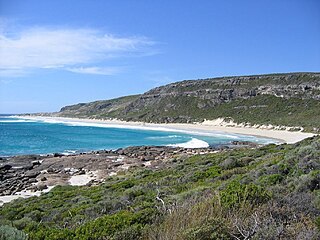
Leeuwin-Naturaliste National Park is a national park in the South West region of Western Australia, 267 km (166 mi) south of Perth. It is named after the two locations at either end of the park which have lighthouses, Cape Leeuwin and Cape Naturaliste. It is located in the Augusta-Margaret River and Busselton council areas, and is claimed to have the highest visiting numbers of any national park in Western Australia. The park received 2.33 million visitors through 2008–2009.

Busselton is a city in the South West region of the state of Western Australia approximately 220 km (140 mi) south-west of Perth. Busselton has a long history as a popular holiday destination for Western Australians; however, the closure of the Busselton Port in 1972 and the contemporaneous establishment of the nearby Margaret River wine region have seen tourism become the dominant source of investment and development, supplemented by services and retail. The city is best known for the Busselton Jetty, the longest wooden jetty in the Southern Hemisphere.
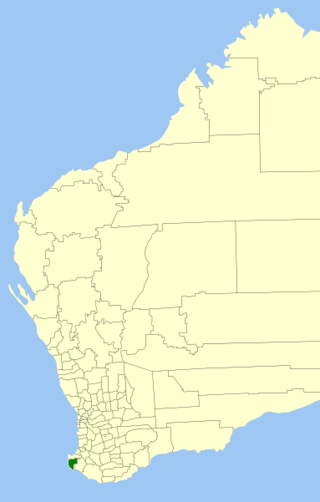
The Shire of Augusta Margaret River is a local government area in the south-west corner of the South West region of Western Australia, approximately 270 kilometres (168 mi) south of Perth. The shire covers an area of 2,243 square kilometres (866 sq mi) and had a population of over 14,000 at the 2016 Census, about half of whom live in the towns of Margaret River and Augusta.
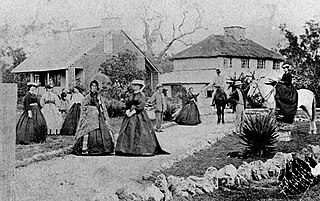
The Bussell family were a family of early settlers in colonial Western Australia. The four brothers John, Joseph Vernon, Alfred and Charles emigrated from England on Warrior, arriving at Fremantle on 12 March 1830. Lenox, Frances and Elizabeth arrived at Fremantle on Cygnet on 27 January 1833, and Mrs Frances Louisa and Mary arrived at Albany on 19 June 1834.

Cape Leeuwin is the most south-westerly mainland point of the Australian continent, in the state of Western Australia.

Augusta is a town on the south-west coast of Western Australia, where the Blackwood River flows into Flinders Bay. It is the nearest town to Cape Leeuwin, on the furthest southwest corner of the Australian continent. In the 2001 census it had a population of 1,091; by 2016 the population of the town was 1,109.
Captain John Molloy was an early Irish settler in Western Australia. He was one of the original settlers of Augusta and an early settler of Busselton.

John Garrett Bussell was an early settler in Western Australia.
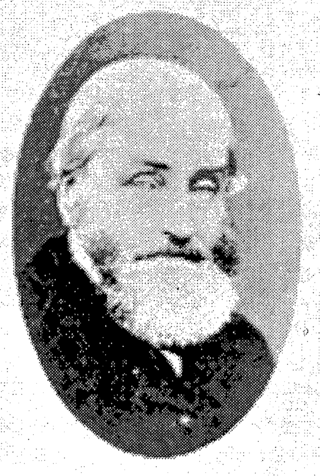
Alfred Pickmore Bussell was an early settler in Western Australia.
Dunsborough is a coastal town in the South West of Western Australia, 254 kilometres (158 mi) south of Perth, on the shores of Geographe Bay.
Samuel Yebble Isaacs was an Aboriginal Australian stockman and farmer from the South West of Western Australia, who was best known for his role in the rescue of the SS Georgette in 1876, together with Grace Bussell.

Bussell Highway is a generally north–south highway in the South West region of Western Australia. The highway links the city of Bunbury with the town of Augusta and is approximately 140 kilometres (87 mi) in length. The highway is signed State Route 10, except in Busselton where the construction of the Busselton Bypass in 2000 resulted in this stretch being changed to Alternate State Route 10 with the Bypass signed State Route 10.
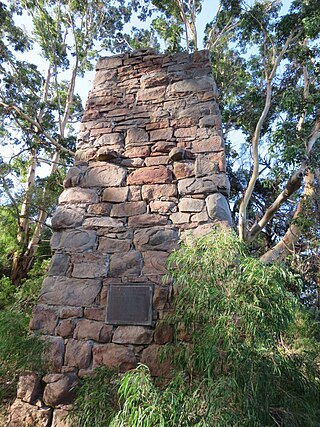
Karridale is a small township in the south-west of Western Australia. It is located just north of Augusta and south of Margaret River between Caves Road and Bussell Highway. A newer township was built a short distance north east of the original Old Karridale following fires that destroyed the town in 1961. At the 2006 census, Karridale had a population of 285.

Boranup, in the Shire of Augusta-Margaret River in the South West region of Western Australia, is the site of a large coastal dune blow out known as the "Boranup sand patch" as part of the Boranup beach, and the site of a former M. C. Davies timber company mill. The sand patch area and sand blows affected the alignment of the Busselton to Flinders Bay railway.
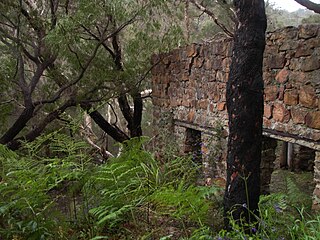
Wallcliffe House was a heritage listed two-storey stone, shingle and corrugated iron homestead located near Prevelly and the mouth of the Margaret River in Western Australia. It was built by George Holland Knapton for owners Alfred and Ellen Bussell between 1857 and 1865 in the Victorian-Georgian style, using limestone quarried on the property and pit-sawn jarrah.
Caves Road is a 111-kilometre-long (69 mi) scenic route in the South West region of Western Australia. It connects western Busselton with Augusta, running along or to the west of the Leeuwin-Naturaliste ridge, and is an alternative route to Bussell Highway. Caves Road is also a major component of the route from Cape Naturaliste to Cape Leeuwin, in what is known as the state's Capes Region.
The Wonnerup massacre, also known as the Wonnerup "Minninup" massacre , was the killing of dozens of Wardandi Noongar people by European settlers in the vicinity of Wonnerup, Western Australia in February 1841. The massacre on Wardandi-Doonan land in the south-west of Western Australia took place after Gaywal/Gaywaar, a Wardandi Man, speared and killed George Layman, a settler at Wonnerup on 21 February 1841. The leaders of the punitive massacre were Layman's neighbours John Bussell and Captain John Molloy, resident magistrate of the district. Settlers from the Wonnerup, Capel, Busselton and Augusta area joined them to commit "one of the most bloodthirsty deeds ever committed by Englishmen".
Yebble is a locality in the South West region of Western Australia in the Shire of Augusta-Margaret River. Established in 2021 from parts of the localities of Gracetown and Burnside, its name honours Sam Isaacs, whose Aboriginal name was Yebble, a stockman who was involved with Grace Bussell in the rescue of the SS Georgette in 1876. The locality is mostly covered by the Leeuwin-Naturaliste National Park and also contains Ellensbrook homestead and the Meekadarribee Falls, which are significant to the local Wardandi people. Yebble is near the land that was granted to Isaacs by the Western Australian government.















